“You have so much talent” or “I’m not talented enough” are powerful statements, statements I hear on a regular basis from those who long for a creative practice. The idea of talent can cause an incredible amount of inaction, of people not feeling they are “good enough” to even try. I see this, in particular, with the visual arts. But the first time you put pen to paper, if you aren’t Picasso or Monet, you might as well forget about it. This larger cultural ideal, of course, seems at odds with the druid tradition where Eisteddfod and the channeling of Awen are central to our spiritual life. In the druid tradition, creativity isn’t about producing something of commercial value or high quality, its about the channeling of creativity for spiritual purposes. But for those coming out of mainstream Western culture with all of the cultural baggage, this can be difficult to institute such a mindset shift.
As I mentioned in my post last week, the reason I took the last few weeks off of blogging was so that I could turn my attention to another project–doing the analysis and writing the paper for the OBOD’s 19th Mt. Haemus lecture. My work in the mundane world is as a professor and a learning researcher; I study how people learn, develop over time, and transfer/adapt that learning to a wide variety of circumstances. And so, understanding bardic development as a learning process is tied to some of that broader research I’ve been doing for a long time. Over the last five months, I conducted an empirical study of the bardic arts in the druid tradition, surveying 266 druids from 9 countries as well doing in-depth interviews 14 participants at different points in their bardic development. I talked to people about their bardic arts, their successes, and their struggles, and gained a deep understanding of what the bardic arts do–and can do–for us as a spiritual practice. The results were heartening, uplifting, and amazing. The study itself will be published by OBOD on Beltane 2018 (and I’ll share a link on the blog when it is posted) so I’m not going to talk too much about it here. However, I did want to share a specific piece of the study, almost a prequel if you will, and talk more about the bardic arts from a developmental perspective.
You’ve Got Talent!
In the process of doing this research and just over time in sharing my own visual art, it seems clear that words alone are not enough to encourage people to break through the “talent” barrier and create, even for those who long for such a creative/bardic practice. In the last few weeks, I have had conversations with people about the study, and multiple conversations go something like this:
Friend: Dana, you are so talented! You should sell your work!
Me: Actually, I practice a lot. I spend at least 10-15 hours in my art studio most weeks and have done that for over 12 years.
Friend: I wish I had your talent!
Me: If you set your mind to it and devoted effort, you could make great strides and produce things you are happy with.
Friend: No, I’m not good at it. I just couldn’t. I don’t know where to begin.
Me: No, really, you could. You just have to start somewhere and keep practicing. Take a class. Come here, we can do art together.
Friend: It’s easy for you to say that because you are talented.
Me.: I haven’t always been this way. I have to work hard.
Friend: I’ll never be talented like you.
Me: …
The problem with this conversation is at least twofold: first, the person assumes that because they aren’t “good” at something the first time they try it, they shouldn’t try at all. Yet, if we know one thing in educational research and human history, it is that humans have an incredible capacity to learn and adapt over time. Denying oneself the opportunity to learn something new, grow, and learn a new skill is almost like denying that innovative and creative part of yourself that longs for expression. In fact, studies of human development in a variety of contexts (including some of my own exploring writers’ development over long periods of time) show that even people who aren’t “good” at all when they start can gain incredible amounts of proficiency and skill in the long run. The key is taking the first steps on that path. The second challenge with this conversation, from my perspective, is that anything I say doesn’t make a difference because I am “talented.” After several frustrating conversations just like this, and in seeing where some of my study participants struggled, I realize that maybe the best way to address this issue isn’t in conversation, but rather, with actual physical evidence of an artist’s development over a period of time. And so, in the remainder of this post, I wanted to share a bit of my own bardic development. I use myself as a model for a few reasons. First, I am finding myself more and more often in a place where people talk about how I’m “very talented” and it “comes naturally” (incredibly ironic, given the rest of this post!) Second, I think the only way for people to understand how real learning happens is to have good models, models not just of success, but also of how people worked through failure, so I’m hoping to provide one. The truth is, regardless of how much I love doing art and the spiritual benefits it offers, I still have to work hard at it, and have worked hard at it for 12 years, and that counts for a lot more than any innate “talent” I may have had when I first picked up a paintbrush. And I still have plenty of times where it doesn’t work out well, lots of “failures” and attempts that don’t pan out.
A Story of Bardic Development
When I was a child, I grew up in a family of artists; my parents were graphic designers, and that’s how they made their living. I made a lot of art as a child, but as a teenager starting to consider options for my future, I distanced myself from it. To me, art was associated with not having enough, and I watched my parents struggle to make ends meet in a rust belt economy that was quickly seeing all of their clients leave the area. Art, to me, was a thing I couldn’t do, something forbidden, some that would somehow pull me into that world of economic struggle. Becuase I loved art so much, I felt I would get sucked into it, and end up loving it so much that I wouldn’t want to do anything else. Circular logic, to be sure, but it prevented me from doing any art from about the age 15 to the age 25. When I decided to attend college and was trying to select a major, my parents asked me to do anything but be an artist. After one year as a miserable computer science student, I settled on Writing instead (which was another love of mine). But all through this time, I wouldn’t let myself near art supplies, I wouldn’t create, and I certainly wouldn’t think about art.
When I was 25, so many things in my world shifted. I lost a dear friend to cancer, I found my spiritual path of druidry, and congruently, as part of my own bardic/spiritual practice, I began to seriously take up visual arts again: painting, primarily, but also a range of other art forms (jewelry, mixed media, bookbinding, etc). Of course, I hadn’t practiced artwork in over a decade. I didn’t have a style, I didn’t have a theme, I just knew that in my pain and sorrow, I wanted to do something creative. I wanted to visualize it, to paint out the pain, so to speak, and so I bought some supplies and started painting. I hadn’t practiced much, I wasn’t very good, and I had no idea what I was doing.
Example #1: Artist Trading Cards
Fairly quickly, I stumbled upon something called Artist Trading Cards (ATCs) which were great for my graduate student budget and time–they were little 2.5 x 3.5″ pieces of artwork that artists made and traded all over the world through various websites. I wasn’t very good at these and my first attempts were lackluster, but the community was super supportive (with no judgment) and I quickly realized how much I enjoyed creating these small works of art. After many failed attempts (which I didn’t photograph, unfortunately), I started trading them with people. So in 2006-2008 or so, my mini works of art I was willing to trade and photograph looked a lot like this:
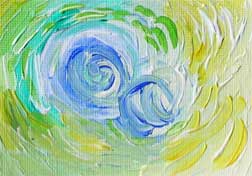


As I continued to paint hundreds of these cards, and challenge myself outside of my normal media, I started getting better. A lot better. I took classes, I explored different media, I focused on the technical aspects of the craft. I watched a lot of YouTube to see how other artists went about their processes. I took on challenges that I knew were too hard so that I’d get better even if I failed in the attempt. I kept trying to hone my craft as an artist. I started a “reject” box for all the art that I wasn’t happy with and didn’t want to trade; I saw that box as my “improvement” and “practice” box. As I improved, I developed a style, and found tools and media that I really liked (a particular kind of paper, a particular brush, a particular paint) that I could rely on for effect. And I improved:
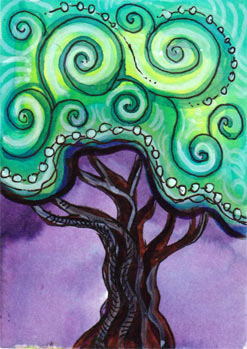


I did these little pieces of art seriously for about 7 years. In that time, I painted literally thousands of them. I know this because each one I painted, I traded to another artist and I have a shelf of binders full of the pieces I received in return still in my art studio to this day. Thousands and thousands of mini paintings on a variety of subjects (but about half of the trees) will certainly help you improve. Just recently, at the start of 2018, I completed some more ATCs as gifts for my interview participants in the Bardic Study. My style and complexity have continued to improve, so here’s where I’m at with this same size (and same paints/media/paper that I like):



Practice and dedication to one’s art, over a period of time, produce results. Is there something to be said for vision, for inspiration, and for “talent”? Perhaps, but I don’t think any of that is what has gotten me to where I am today. What got me here was a willingness to make mistakes, a willingness to try and attempt, a dedication to improving my skill, and a lot of hard work and determination. What keeps me going are the intrinsic and spiritual benefits I gain from such a practice.
Example #2: Tarot of Trees and new Plant Spirit Oracle
As a second example, which in some ways is much more drastic because it is at a larger size, we might look at the comparison between my self-published tarot deck, the Tarot of Trees and a new project I’m currently working on. The Tarot of Trees reflects my skill level between 2008-2009 after I had been painting a few years; my new project, the Healing Plant Spirit Oracle reflects my style in 2016-2018. The Tarot of Trees really pushed my skills at the time and also helped me really establish not only my own artistic style but also, the synthesis of the creative arts with my spirituality–a true bardic art. I did this as sacred artwork, completing them in a sacred grove, painting, channeling the Awen. And like any of my other paintings and projects, I had a few that didn’t end up in the deck and didn’t pan out, but that’s part of the process. Here are two of my favorite cards from the Tarot of Trees:
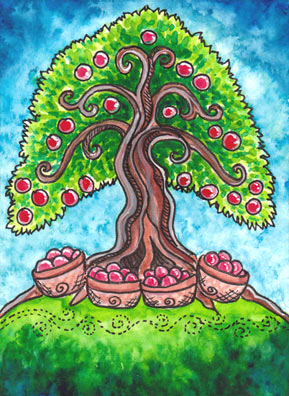

My newest oracle project got underway in 2016–a series of plant spirit paintings, reflecting the spirit of healing plants. I’ve been really, again, working on the synthesis between my technical skill and spiritual practices. To deepen my technical skill, particularly my drawing skill, I’ve been doing individualized drawing studies and studying the work of other artists. I’ve also gotten regular expert feedback from artists on these pieces. These plant spirit paintings are, once again, pushing me out of my comfort zone. Here are a few of my favorite pieces from the series (which I hope to have complete by 2020):
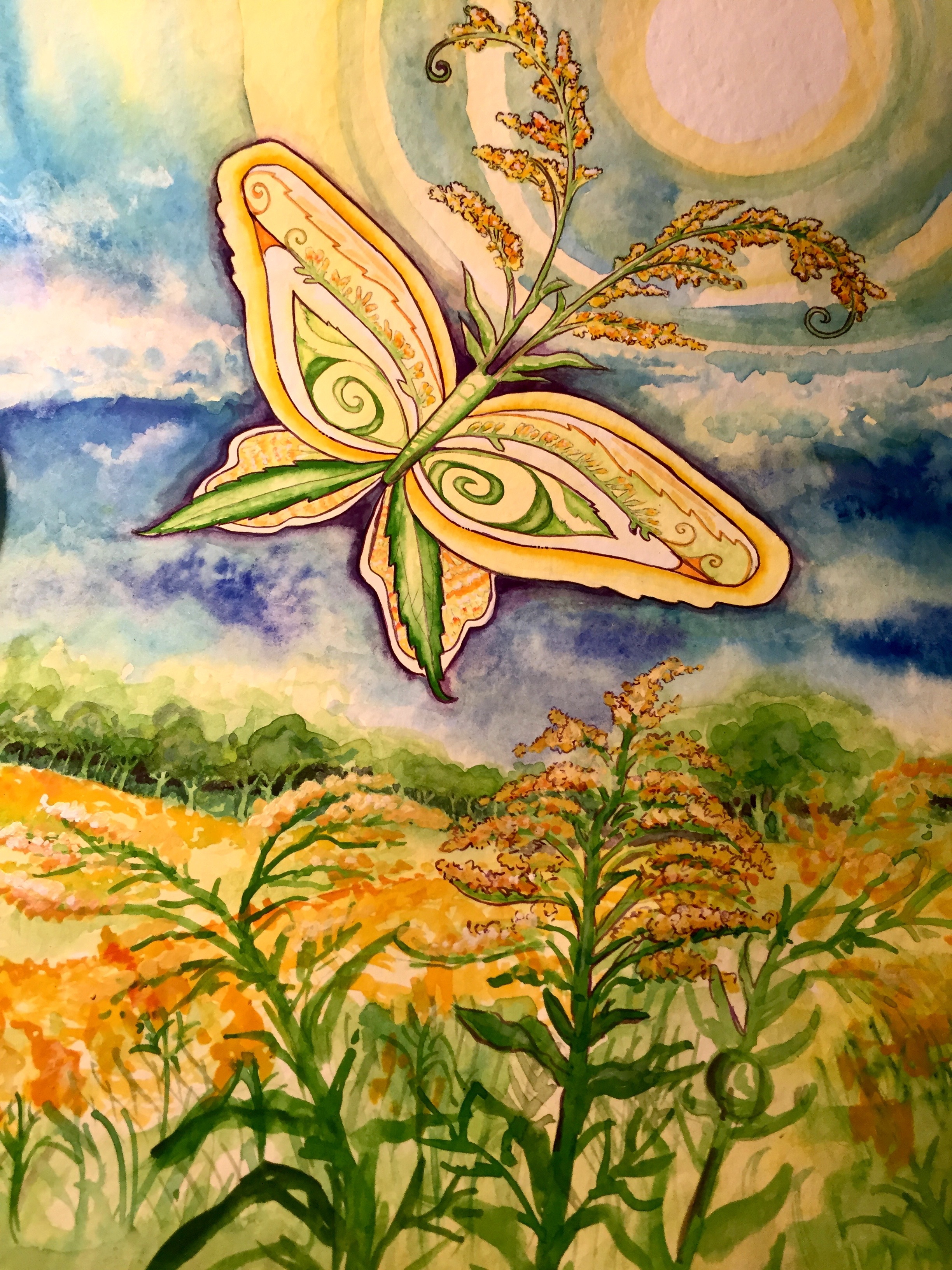
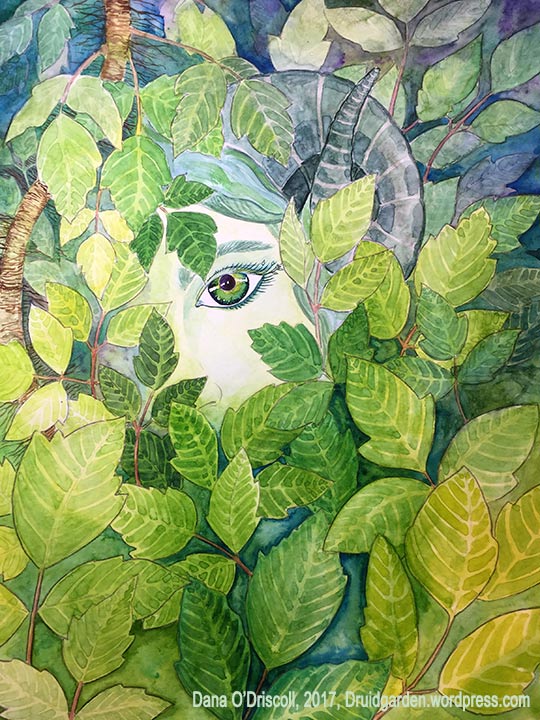
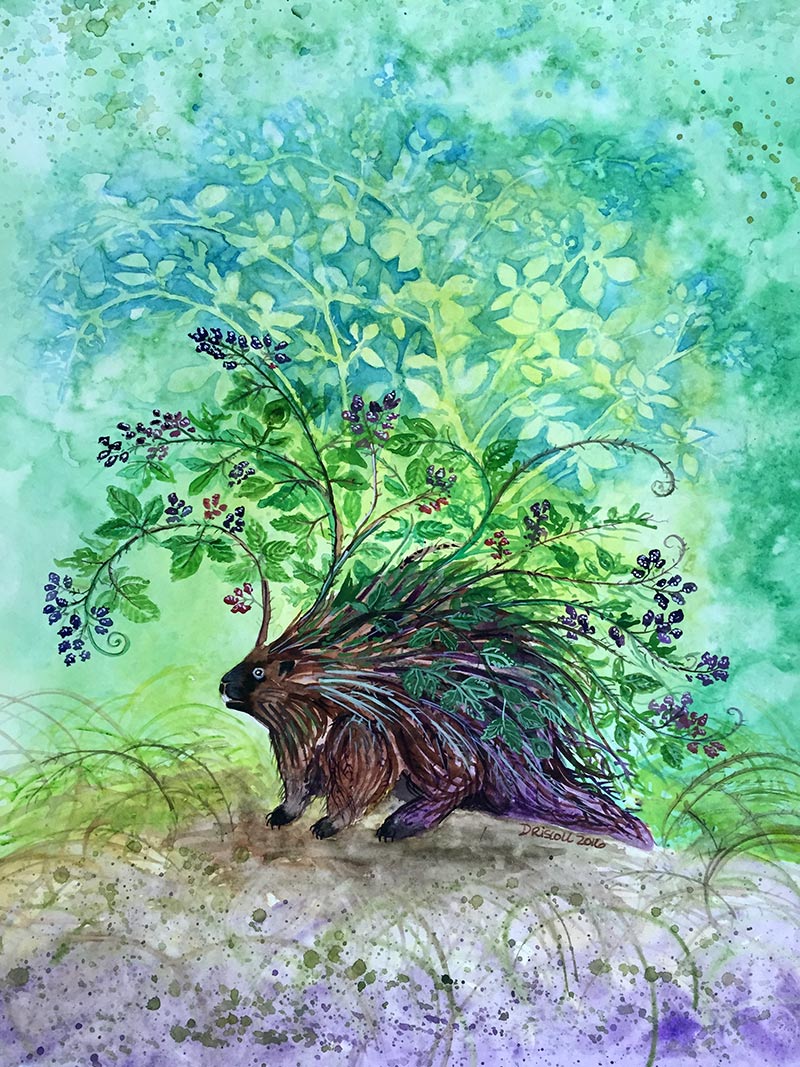
Certainly, there is magic here, but it lies not in raw talent, but rather, the careful application of the skills I’ve honed to bring forth a particular vision combined with channeling the Awen that is flowing. Paintings like these don’t happen without considerable effort and work–I do a lot of meditation, journeying, sketching, and more to manifest them in the world. As evidence of this, here is a page from my sketchbook that shows just this for poison ivy (I worked on the sketches for this for several sittings before doing a larger sketch that led to the painting):

Concluding Thoughts
I think it’s easy to look at, see, or hear something beautiful and feel that the piece must have emerged out of the ether and is the result of some mystical talent. And yet, I’m a druid who channels Awen and even I don’t believe that. For every person I know who has considerable skill and expertise (notice how I’m avoiding the word “talent” here), I know that their work is a product of years of dedication to their craft. In fact, think the most ironic thing about the whole “talent” challenge in modern society is that by ascribing to this idea of talent, it undermines the hard work that people who are dedicated to an art or craft take to hone their skill. By telling someone that they are talented, we reinforce the idea that it magically happens and you either have it or you don’t–and in my experience, this couldn’t be further from the truth. It disempowers the speaker, it disregards the effort of the person who has practiced, and it makes the bardic arts unattainable for many. In truth, we all can improve, we all can become highly skilled if we put the time into it.
So how do we do this? My earlier pieces in this series, Taking up the Path of the Bard part I and Taking up the Path of the Bard, Part II, offered details and discussion of how we can begin to develop creative and spiritual practice in our own lives. I’ve talked about the bardic arts as a spiritual practice, the historical idea of honing skill, channeling the flow of Awen, and other kinds of rituals to help empower us as bards. Hopefully, among all of these blog posts, you’ll find something of value!
Blessings upon your bardic journey and may the Awen flow within!



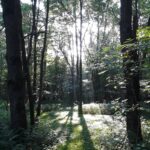
Reblogged this on Paths I Walk.
Thanks for the reblog! 🙂
Hello-t it dropped into my email box at just that right moment 🙂 the one of immense self doubt when embarking on creativity. So thank you for blogging and thank you for sharing your message about practice and lovely works and studies
Nicky, I’m glad you found this inspirational. I wonder how you can transform that self doubt into self love? Just allowing yourself to be free of your own expectations and create anything….blessings on that bardic journey!
This is so true, and something we don’t hear enough in our culture. As someone who struggles to start anything in case its not good enough…thank you!
Absolutely! Its kind of like tree planting….the best time to plant a tree is 20 years ago. The second best time is now. The best time to pickup a bardic practice was 20 years ago, and the second best time is now :).
Reblogged this on Rattiesforeverworldpresscom.
Wonderful and true article 🙂
Thank you for the reblog 🙂
you re very welcome :p
Thank you Dana. Once again you bring joy while making your point
Thank you, Patrick! And thank you for reading 🙂
Your plant oracle paintings are beautiful! I look forward to seeing more about that project.
I agree wholeheartedly about how ideas of talent get in the way of expression, even with those who are supposedly “talented.” I’ve seen so much unnecessary angst in those I love over it. The idea of talent gets in the way of the practice, the work, the creation. Everyone’s creative work is in process. It’s where you are on your own timeline.
Talis, thank you for the comment and for reading. I have watched so many people with potential fail to try because of “talent” and the myths of it. We are all in the process of becoming and the journey is what matters!
Reading this made me think of my medicine cup. When I want to deepen my understanding of a medicinal herb, or introduce myself to a new one, I brew some up in my medicine cup and drink it in a state of mindful attentiveness.
The cup is wonderfully evocative of nature. With its squat form and crosshatch glazing in dark brown, tan, and a touch of green, it’s like drinking from a little stump. It was clearly hand made by someone with very little practice, but with good instruction and a great deal of mindful attentiveness. The thickness of the wall is impressively consistent and the handle is still attached after all this time. The initials etched on the bottom are C B.
That’s the guy who sold me this trailer. I’ll never know if he continued with pottery crafting or what. I’m just glad he decided not to throw away his non-masterpiece. Instead, he left behind an object infused with just the right energies I would want in a medicine cup.
I love this story! I hope that CB is still creating pottery and that each piece offers much to the owners :). Thanks for the comment!